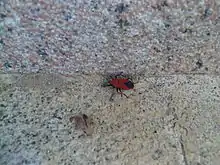Antilochus coquebertii
Antilochus coquebertii (often misspelled as coqueberti) is an Old World species of true bug in the family Pyrrhocoridae, occurring in South and Southeast Asia. It is brightly coloured, red and black, and is a beneficial predator on other pyrrhocorids, especially the genus Dysdercus, which are crop pests.[1] They are often confused with bugs in the family Lygaeidae, but can be distinguished by the lack of ocelli on the head, and they can be easily distinguished from Dysdercus by the lack of white stripes on the body. They are known to be cannibalistic in nature, but are not known to prey on human flesh or blood. [2]
| Antilochus coquebertii | |
|---|---|
 | |
| specimen from Hong Kong | |
| Scientific classification | |
| Kingdom: | |
| Phylum: | |
| Class: | |
| Order: | |
| Suborder: | |
| Family: | |
| Genus: | |
| Species: | A. coquebertii |
| Binomial name | |
| Antilochus coquebertii (Fabricius, 1803) | |
| Synonyms | |
|
Lygaeus coquebertii Fabricius, 1803 | |
References
- Ahmad, I., & Schaefer C. W. (1987). Food plant and feeding biology of the Pyrrhocoroidea (Hemiptera). Phytophaga 1: 75-92.
- "Predatory Red Bugs from India: Antilochus conqueberti". What's That Bug?. 2015-07-30. Retrieved 2019-03-17.
This article is issued from Wikipedia. The text is licensed under Creative Commons - Attribution - Sharealike. Additional terms may apply for the media files.